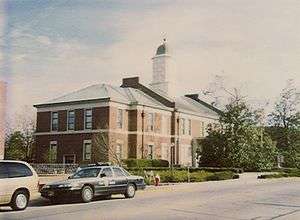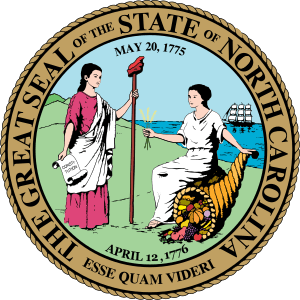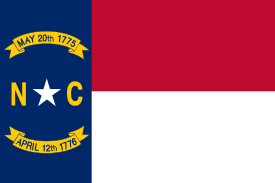Onslow County, North Carolina
Onslow County is a county located in the U.S. state of North Carolina. As of the 2010 census, the population was 177,772.[1] Its county seat is Jacksonville.[2] The county was created in 1734 as Onslow Precinct and gained county status in 1739.[3]
Onslow County | |
|---|---|
 The 1904 Onslow County Courthouse | |
 Seal | |
 Location within the U.S. state of North Carolina | |
 North Carolina's location within the U.S. | |
| Coordinates: 34°43′N 77°25′W | |
| Country | |
| State | |
| Founded | 1739 |
| Named for | Arthur Onslow |
| Seat | Jacksonville |
| Largest city | Jacksonville |
| Area | |
| • Total | 906 sq mi (2,350 km2) |
| • Land | 763 sq mi (1,980 km2) |
| • Water | 143 sq mi (370 km2) 16%% |
| Population | |
| • Estimate (2019) | 197,938 |
| • Density | 233/sq mi (90/km2) |
| Time zone | UTC−5 (Eastern) |
| • Summer (DST) | UTC−4 (EDT) |
| Congressional district | 3rd |
| Website | www |
Onslow County comprises the Jacksonville, NC Metropolitan Statistical Area. The southern border is the coast of the Atlantic Ocean.
History
European, mainly English, settlers arrived here in 1713 in what was originally part of the colonial precincts of Carteret and New Hanover. Onslow County was formed in 1734 and was named for Arthur Onslow, the longest serving speaker of the House of Commons. After a lethal 1752 hurricane, the county courthouse was relocated from Town Point to Wantland's Ferry; this settlement was eventually incorporated in 1842 and named Jacksonville after President Andrew Jackson. Through much of the first half of the 20th century, the county was largely rural, with an economy based on agrarian and maritime communities.
During World War II, Onslow County was dramatically changed in the early 1940s with the establishment of the United States Army Camp Davis near Holly Ridge (now defunct), and the creation of Camp Lejeune in 1941. This increased county population and generated related growth in housing and businesses.
Onslow County's flat, rolling terrain covers 767 square miles (1,990 km2) and is located in the southeastern coastal plain of North Carolina, about 120 miles (190 km) east of Raleigh and 50 miles (80 km) north of Wilmington. The city of Jacksonville is the county seat, and the areas surrounding the city constitute the major population centers and growth areas in the county. The county is home to more than 150,000 people and includes the incorporated towns of Holly Ridge, Richlands, Swansboro, North Topsail Beach, part of Surf City, and unincorporated Sneads Ferry. The U.S. Marine Corps Base, Camp Lejeune, comprises roughly 156,000 acres (630 km2); more than 43,000 marines and sailors are stationed there.
Geography
According to the U.S. Census Bureau, the county has a total area of 906 square miles (2,350 km2), of which 763 square miles (1,980 km2) are land and 143 square miles (370 km2) (16%) are covered by water.[4]
Adjacent counties
- Jones County - north
- Carteret County - east
- Pender County - southwest
- Duplin County - northwest
Demographics
| Historical population | |||
|---|---|---|---|
| Census | Pop. | %± | |
| 1790 | 5,387 | — | |
| 1800 | 5,623 | 4.4% | |
| 1810 | 6,669 | 18.6% | |
| 1820 | 7,016 | 5.2% | |
| 1830 | 7,814 | 11.4% | |
| 1840 | 7,527 | −3.7% | |
| 1850 | 8,283 | 10.0% | |
| 1860 | 8,856 | 6.9% | |
| 1870 | 7,569 | −14.5% | |
| 1880 | 9,829 | 29.9% | |
| 1890 | 10,303 | 4.8% | |
| 1900 | 11,940 | 15.9% | |
| 1910 | 14,125 | 18.3% | |
| 1920 | 14,703 | 4.1% | |
| 1930 | 15,289 | 4.0% | |
| 1940 | 17,939 | 17.3% | |
| 1950 | 42,047 | 134.4% | |
| 1960 | 82,706 | 96.7% | |
| 1970 | 103,126 | 24.7% | |
| 1980 | 112,784 | 9.4% | |
| 1990 | 149,838 | 32.9% | |
| 2000 | 150,355 | 0.3% | |
| 2010 | 177,772 | 18.2% | |
| Est. 2019 | 197,938 | [5] | 11.3% |
| U.S. Decennial Census[6] 1790-1960[7] 1900-1990[8] 1990-2000[9] 2010-2019[1] | |||
As of the census[10] of 2000, 150,355 people, 48,122 households, and 36,572 families resided in the county. The population density was 196 people per square mile (76/km²). The 55,726 housing units averaged 73 per square mile (28/km²). The racial makeup of the county was 72.06% White, 18.48% African American, 0.74% Native American, 1.68% Asian, 0.19% Pacific Islander, 3.62% from other races, and 3.22% from two or more races. About 7.25% of the population were Hispanic or Latino of any race.
Of the 48,122 households, 42.60% had children under the age of 18 living with them, 61.00% were married couples living together, 11.60% had a female householder with no husband present, and 24.00% were not families. About 18.60% of all households were made up of individuals and 5.20% had someone living alone who was 65 years of age or older. The average household size was 2.72 and the average family size was 3.09.
In the county, the population was distributed as 26.20% under the age of 18, 23.80% from 18 to 24, 29.20% from 25 to 44, 14.40% from 45 to 64, and 6.30% who were 65 years of age or older. The median age was 25 years. For every 100 females, there were 123.20 males. For every 100 females age 18 and over, there were 131.30 males.
The median income for a household in the county was $33,756, and for a family was $36,692. Males had a median income of $22,061 versus $20,094 for females. The per capita income for the county was $14,853. About 10.80% of families and 12.90% of the population were below the poverty line, including 16.70% of those under age 18 and 14.70% of those age 65 or over.
Education
Elementary schools
|
|
|
Middle schools
|
|
High schools
|
|
Communities
City
- Jacksonville (county seat)
Census-designated places
Politics, law, and government
Onslow is a typical "Solid South" county in its voting patterns. Except for the 1928 election when anti-Catholic voting allowed Herbert Hoover to carry the county in 1928, it was solidly Democratic until 1968, during the FDR years by margins of as much as 13 to one in 1936. However, the 1960s onwards had Onslow turn to George Wallace in 1968 and then overwhelmingly to Richard Nixon over George McGovern in 1972. Since then, Onslow has become a strongly Republican county; the last Democrat to carry it was Jimmy Carter in 1976 and Carter in 1980 remains the last of his party to top 40%.
| Year | Republican | Democratic | Third parties |
|---|---|---|---|
| 2016 | 65.0% 37,122 | 30.7% 17,514 | 4.4% 2,499 |
| 2012 | 62.7% 32,243 | 36.0% 18,490 | 1.4% 702 |
| 2008 | 60.3% 30,278 | 38.8% 19,499 | 0.9% 426 |
| 2004 | 69.5% 25,890 | 30.2% 11,250 | 0.4% 137 |
| 2000 | 65.1% 19,657 | 34.0% 10,269 | 1.0% 289 |
| 1996 | 55.7% 13,396 | 36.1% 8,685 | 8.2% 1,968 |
| 1992 | 48.7% 11,842 | 33.1% 8,045 | 18.2% 4,431 |
| 1988 | 62.9% 12,253 | 36.8% 7,162 | 0.4% 73 |
| 1984 | 70.8% 13,928 | 29.0% 5,713 | 0.2% 46 |
| 1980 | 53.0% 8,861 | 44.0% 7,371 | 3.0% 504 |
| 1976 | 42.6% 5,953 | 56.9% 7,954 | 0.5% 63 |
| 1972 | 80.1% 10,343 | 18.8% 2,424 | 1.2% 154 |
| 1968 | 28.1% 3,444 | 26.8% 3,281 | 45.2% 5,542 |
| 1964 | 38.8% 3,771 | 61.2% 5,955 | |
| 1960 | 33.6% 2,812 | 66.4% 5,564 | |
| 1956 | 25.7% 1,626 | 74.3% 4,692 | |
| 1952 | 22.8% 1,261 | 77.2% 4,275 | |
| 1948 | 8.3% 316 | 87.3% 3,318 | 4.4% 165 |
| 1944 | 13.8% 433 | 86.2% 2,711 | |
| 1940 | 10.2% 271 | 89.8% 2,383 | |
| 1936 | 7.9% 235 | 92.2% 2,758 | |
| 1932 | 8.8% 253 | 90.9% 2,615 | 0.3% 9 |
| 1928 | 53.9% 1,253 | 46.1% 1,072 | |
| 1924 | 26.8% 423 | 71.2% 1,122 | 2.0% 31 |
| 1920 | 35.4% 853 | 64.6% 1,557 | |
| 1916 | 39.5% 785 | 60.3% 1,197 | 0.2% 4 |
| 1912 | 4.4% 66 | 59.4% 901 | 36.3% 550 |
Onslow County is a member of the regional Eastern Carolina Council of Governments.
The structure of local government in Onslow County was changed in 2016 to have seven commissioners in 2018 board of commissioners, all elected at-large for four-year terms. In contrast to electing members from districts, this structure means that candidates are elected by the majority population in the county, which gives a more accurate view of the entire electorate. On November 8, 2016, citizens voted in favor to alter the number of commissioners from five commissioners with concurrent terms to seven with staggered terms. In 2018, citizens elected two more county commissioners in the general election on November 6, 2018, to four-year terms. The citizens of the county will elect five commissioners in 2020, but the four candidates who receive the highest number of votes in the general election of 2020 will receive a four-year term and the candidate who receives the fifth-highest number of votes in the general election of 2020 to a two-year term. Thereafter, all county commissioners would be elected to serve four-year terms. The board establishes policies and ordinances implemented by the county manager and his staff. Commissioners are Jack Bright (chair), Royce Bennett (vice chair), Paul Buchanan, Robin Knapp, Mark Price, Tim Foster, and William Shanahan.
In the North Carolina Senate, Onslow County is located in the 6th Senate District, which shares its borders with Jones County. The 6th Senate District is represented by Republican Harry Brown. In the North Carolina House of Representatives, Onslow County is split into three House districts with the 14th and 15th House Districts completely in Onslow County and the 4th House District in part of Onslow County and all of neighboring Duplin County. The 4th District is represented by Republican Jimmy Dixon, the 14th District is represented by Republican George Cleveland, and the 15th District is represented by Republican Phil Shepard.
The main law enforcement agency for Onslow County is the County Sheriff's Department. The elected sheriff is Hans Miller.
Transportation
Airport
The Albert J. Ellis Airport is located in Richlands and is served by two commercial airlines.
Townships
- Jacksonville
- Richlands
- Sneads Ferry
- Southwest
- Swansboro
- White Oak
References
- "State & County QuickFacts". United States Census.
- "Find a County". National Association of Counties. Retrieved 2011-06-07.
- "North Carolina: Individual County Chronologies". North Carolina Atlas of Historical County Boundaries. The Newberry Library. 2009. Retrieved January 25, 2015.
- "2010 Census Gazetteer Files". United States Census Bureau. August 22, 2012. Archived from the original on January 12, 2015. Retrieved January 18, 2015.
- "Population and Housing Unit Estimates". Retrieved May 21, 2020.
- "U.S. Decennial Census". United States Census Bureau. Retrieved January 18, 2015.
- "Historical Census Browser". University of Virginia Library. Retrieved January 18, 2015.
- Forstall, Richard L., ed. (March 27, 1995). "Population of Counties by Decennial Census: 1900 to 1990". United States Census Bureau. Retrieved January 18, 2015.
- "Census 2000 PHC-T-4. Ranking Tables for Counties: 1990 and 2000" (PDF). United States Census Bureau. April 2, 2001. Retrieved January 18, 2015.
- "U.S. Census website". United States Census Bureau. Retrieved 2008-01-31.
- Leip, David. "Dave Leip's Atlas of U.S. Presidential Elections". uselectionatlas.org. Retrieved 2018-03-16.
External links
- Official website
- NCGenWeb Onslow County - free genealogy resources for the county
- Onslow County Schools
- Onslow County Museum

